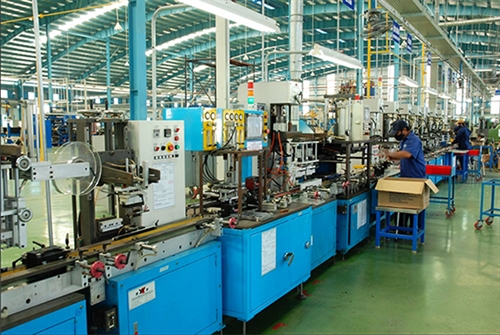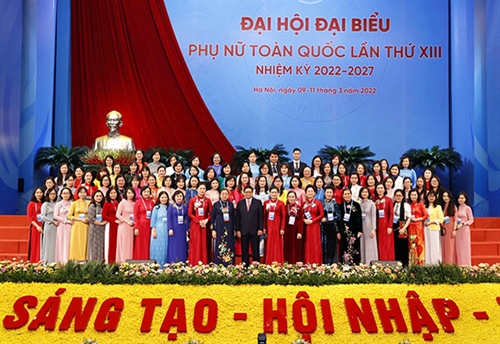One of the strategic breakthrough issues identified by the 13th National Party Congress is the strong development of science, technology and innovation. Currently, in the context of safe, flexible adaptation to and effective control of the COVID-19 pandemic, it is necessary to continue to make institutional breakthroughs for development of science, technology and innovation to create leapfrog changes in labor productivity, quality, efficiency and competitiveness, meeting the requirements of growth model renewal and economic recovery and development.
Assoc. Prof., PhD. Huynh Thanh Dat
Member of the Party Central Committee, Minister of Science and Technology
Role of science, technology and innovation in changing the growth model
Renewing the economic growth model has been consistently affirmed in the line, guidelines and policies of the Party and the State. Resolution 05-NQ/TW, dated November 1, 2016, of the 4th Plenum of the 12th Party Central Committee, affirms the views of renewing the growth model in order to improve the growth quality, labor productivity and competitiveness of the economy and foster fast, sustainable and comprehensive development in all economic, social and environmental fields. The Resolution also confirms the views of not paying any cost for growth thus causing adverse effects on macroeconomic stability, national defense, security, social progress and justice, and preservation of the eco-environment. It underlines the need to focus and increasingly rely on factors promoting labor productivity, efficient use of resources, especially bringing into play the spirit of patriotism, national pride, and creativity of Vietnamese people and scientific and technological achievements of mankind, potential and advantages of all sectors, fields, localities as well as the whole country. It is required to ensure the reasonable combination of extensive growth and intensive growth depending on the practical situation of each sector, field or locality, in which intensive growth is the main direction. Growth based mainly on investment and export will be gradually shifted to that based on investment, export and domestic market; growth reliant on increase in the number of inputs of production will be gradually changed to that reliant on improved labor productivity and quality, application of science, technology and innovation; exploitation and maximum utilization of internal resources will be combined with effective attraction and use of external resources.
The 13th National Party Congress further elaborates on renewal of the growth model as “strongly shifting the economy to a growth model based on increased productivity, scientific and technological advances, innovation, high-quality human resources, economical and efficient use of resources in order to improve the quality, efficiency and competitiveness of the economy”.
Thus, science, technology and innovation play a very crucial role in the transition from the model of extensive growth to a rational combination of extensive growth and intensive growth, simultaneously expanding the scale and improving the quality, efficiency and sustainability in association with growth based on science, technology and innovation, high-quality human resources and economical and efficient use of resources.
The view of renewing the growth model based on science, technology and innovation has posed a number of key requirements for science, technology and innovation. They include contributing to the restructuring of the economy by shifting to advanced and modern fields; promoting the rapid increase of domestic value, added value and competitiveness of products, enterprises and the whole economy; linking economic development with environmental protection, and development of a green economy; promoting the development of products with competitive advantages, hi-tech products with high added value, and effective participation in the global production network and value chain.
In fact, the policy of economic recovery and development in Vietnam is meant to promote faster and stronger renewal of the growth model in the current period. Therefore, science, technology and innovation need to focus on improving Vietnam’s competitiveness compared to other countries around the world in the context of overcoming the impacts of the COVID-19 pandemic, transforming the status of economic activities in conformity with the requirements of co-living with the pandemic, and actively participating in safe, flexible adaptation to and effective control of the pandemic, and raising preventive medicine quality and capacity, ensuring sufficient supply of vaccines and treatment drugs, etc.
 |
| A modern production line of the local car manufacturer VinFast __Photo: VNA |
Central contents in development of science, technology and innovation
From the requirements set forth for renewal of the growth model and economic recovery and development, it is possible to identify the basic and central features in the future development of science, technology and innovation in our country.
Firstly, science, technology and innovation will focus on serving a number of priority orientations in socio-economic development. They should play a decisive role in improving productivity, quality, efficiency and competitiveness of products, goods, services and the economy, especially in developing new products and services, key products and national brands; quickly mastering, absorbing, assimilating and applying the world’s scientific and technological advances; accelerating economic restructuring along the line of increasing the proportion of the value of hi-tech industrial products, industries with high productivity and added value thanks to the application of advanced and modern technologies. Science, technology and innovation should also help promote the development of spearhead industries, particularly processing and manufacturing industries based on the technologies of Industry 4.0; gradually reduce the share of industries with low labor productivity and added value and still applying outdated technologies, thus helping solve social problems arising from the impacts of Industry 4.0, international integration and non-traditional security challenges; propose solutions to innovate society management methods in the condition of digital transformation; and actively contribute to environmental protection, response to climate change, development of green economy and circular economy, etc.
Secondly, to form a number of large national science and technology projects and programs in some key sectors with strengths and potential to address particularly important long-term issues for national development; to restructure science and technology programs and tasks to be linked with social needs, the value chains of products and create added value.
Thirdly, to develop a national innovation system and an innovative startup ecosystem; to accelerate the formation of innovative startup centers, launch the innovation and startup movement nationwide, with businesses playing the central role; to promote the connection of innovation networks at home and abroad.
Fourthly, to promote science, technology and innovation in businesses; to focus on transferring and applying advanced technologies along with improving technology absorption and innovation capacity, improving governance capacity, human resource qualifications and skills, innovating production and business processes, realizing digital transformation, and applying new business models suitable to the process of technological innovation in enterprises.
Fifthly, to renovate the structure of the system of science and technology organizations in line with national and sectoral development priorities toward autonomy, linkage and conformity with international standards; to strongly develop regional and local science, technology and innovation systems; to promote innovation activities in key regions as suitable to regional and local economic advantages; to improve the functions and tasks of and increase investments in human resources, finance and physical facilities for scientific and technological advance application centers under provincial-level Departments of Science and Technology to become focal points for promoting technology transfer and innovation activities in localities; to step by step elevate the standards for traditional products and trades and OCOP products with a view to boosting technological innovation in production.
Sixthly, to intensify international cooperation in order to attract external resources for renewing the growth model and economic recovery and development; to raise the level of science, technology and innovation in the country to follow the trends of the world and reach the advanced levels in various important fields among the leading group of upper middle-income countries.
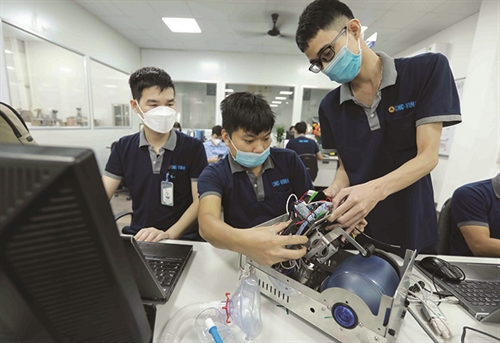 |
Institutional breakthroughs for development of science, technology and innovation
Over the past time, the institutions on science, technology and innovation in Vietnam have achieved certain outcomes, contributing to renewal of the growth model and economic recovery and development. The applied mechanisms and policies show the consistency in materializing the guideline that science and technology development is the top national policy. So far, eight specialized laws on science, technology and innovation development have been enforced. The regulations on intellectual property, quality, measurement and standards, business development, etc., have also been step by step improved.
The state management mindset has been renewed and the law on science and technology has been improved in line with the development trend in the world to better serve the development of science, technology and innovation in Vietnam. The increasingly synchronous legal framework on science and technology has facilitated and fostered fair competition in innovative research, step by step eliminating the red-tape mechanism. Innovation has gradually become a new mindset in management and administration; the central role of enterprises in the national innovation system has been strengthened. The grant of autonomy and accountability to public science and technology organizations has been promoted. The technology and innovation market and the innovative startup ecosystem are growing; science, technology and innovative startup enterprises have been formed; enterprises are encouraged to establish research institutes and invest more in science and technology activities; the model of attracting and employing talented scientists at home and Vietnamese intellectuals overseas has been piloted.
The Ministry of Science and Technology is studying revision of a number of laws and regulations, including the Law Amending a Number of Articles of the Law on Intellectual Property; the Law on Science and Technology; the Law on Standards and Technical Regulations; the Law on Product and Goods Quality; the Law on Atomic Energy; the Strategy for development of science, technology and innovation through 2030, etc., and other sub-law documents to meet the requirements of the new period.
Apart from the achieved results, the institutions on science, technology and innovation in our country still reveal not a few limitations. The regulations on investment, finance and enterprises are not really consistent with a number of provisions of the law on science and technology. The policies on capital, tax and development support have not really been accessible for enterprises of all economic sectors to make investment in technology innovation and research and innovation activities, nor have they facilitated the exchange and trade of domestic and foreign scientific, technological and innovative products on the market.
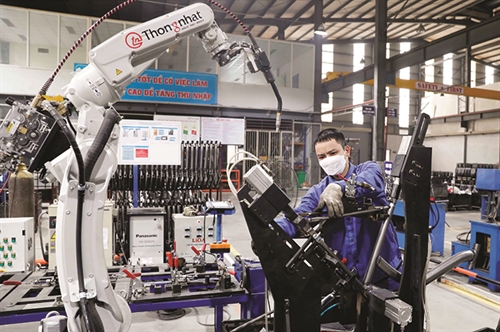 |
Therefore, in face of many current challenges, the development of science, technology and innovation requires the following institutional breakthroughs:
Firstly, allowing the deployment of sandboxes for scientific research, technology development and innovation activities in specific science and technology projects or targeted groups (creative startups in some sectors, research institutes, and universities, etc.).
Secondly, renewing mechanisms, policies and laws on investment, public investment, public procurement, use of the state budget, use of public property, and taxes, and other relevant laws to develop science, technology and innovation activities. It is required to improve the public-private partnership mechanism, the legal corridor for “angel investment”, venture capital funds, community investment funds, digital platforms to raise investment capital, along with diversifying traditional funds to rally more investment resources for science, technology and innovation. It is also a need to formulate mechanisms and policies to facilitate effective linkages between research institutes, universities and enterprises.
Thirdly, reviewing, amending and improving regulations on the autonomy mechanism of public science and technology organizations by allowing them to decide on their own organizational structures, recruit and employ personnel, use funds, and perform science and technology tasks. It is necessary to develop criteria for measuring and evaluating the effectiveness of science, technology and innovation activities of research institutes, universities and enterprises according to international standards.
Fourthly, revising the financial management, payment and settlement regulations, accepting the risk factor in science, technology and innovation activities; creating favorable conditions for enterprises to participate in the performance of science and technology tasks; removing difficulties and obstacles in the transfer of assets formed in the performance of state-funded science and technology tasks.
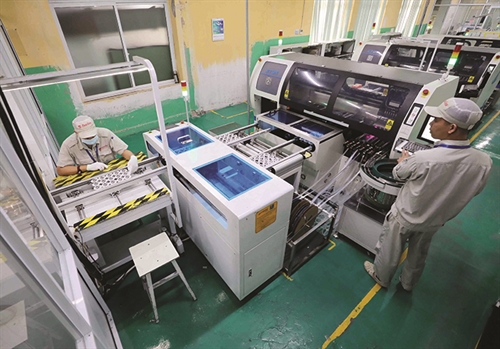 |
Fifthly, revising tax, finance and credit regulations to be consistent with those on science and technology for effectively applying incentive mechanisms to enterprises making investment in scientific research and technology innovation by: (i) shortening the amortization period of machinery and equipment used in scientific research and technology development; and (ii) providing annual tax incentives for enterprises based on actual revenues generated from science, technology and innovation activities, income tax incentives for individuals and businesses with regard to grants for science, technology and innovation activities of research institutes and universities. It is a must to further review, adjust and implement policies and solutions to strongly develop science and technology enterprises, hi-tech enterprises, and innovative startups, making innovative startup activities become one of the breakthrough motives for growth model renewal.
Sixthly, reviewing, evaluating and improving policies on technology import (tax incentives, credit, support, etc.) to promote transfer of advanced technologies from abroad. At the same time, it is required to study and propose revisions to public procurement policies to promote the use of products and services that are outcomes of domestic scientific research and technology development activities.
Seventhly, comprehensively renovating the management and performance of science and technology tasks at all levels to ensure publicity, transparency, objectivity, and simplification of administrative procedures; and carrying out digital transformation of the entire management process and databases of science, technology and innovation resources.
Lastly, unifying the focal points for state management of science, technology and innovation to strongly promote innovation associated with science and technology, serving as a basis for effective coordination in the formulation and implementation of mechanisms and policies conducive to the development of science, technology and innovation. It is a need to streamline the system of state management of science, technology and innovation, focusing on formulating mechanisms, policies, strategies, master plans and plans.-



